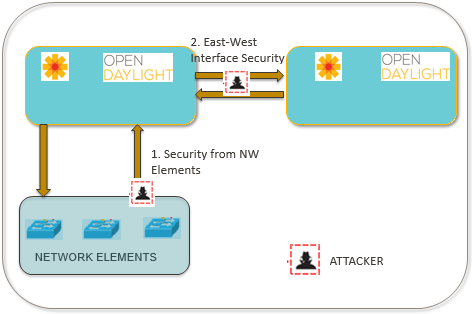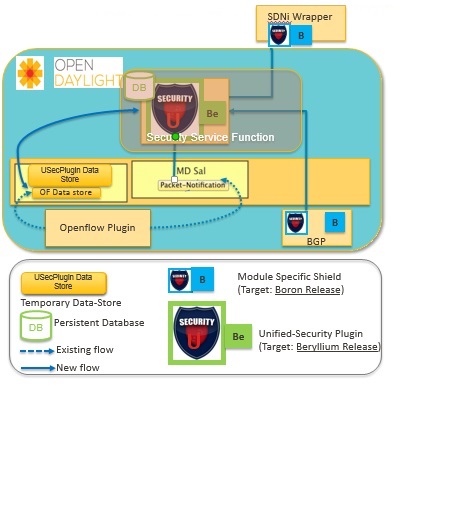Name
Unified Controller Security plugin
Repo Name
USecplugin
Description
The SDN controller is identified as the single most important point of failure that can affect the entire network. Hence, securing the controller from external sources of attack is of paramount importance. The attack on the controller could be from the application, network or the peer controllers that are connected via the east-west interface. While the controller may be protected from the network by adding additional layers of security before the packets can reach the controller, the rationale behind a unified controller security plugin is to devise an security information repository for the NB applications that may be designed to protect the controller from external security threats.The Unified Security Plugin (USecPlugin) is developed for ODL controller as an infra that provides a single pane of visibility related to controller security and expose the same to third party, north-bound applications. The security information could be for various purposes such as collating source of different attacks reported in SB plugins / suspected controller intrusions or information about trusted controllers in the network. Information collected at the plugin may also be used to configure Firewalls and create IP Blacklists for the network.
Following figure depicts the overview of Controller attack surfaces that needs protection:
Following Use-Cases have been presently identified for the USecPlugin:
• (1) Security from Network Elements - This covers security for the controller from DDoS attacks originating from Switches/Hosts in the network. The information about the attributes of the packet contributing to the attack may be updated in the USecPlugin to correlate information about perpetrators of the attack.
• (2) East-West Interface Security - East-West connectivity between unauthenticated can potentially expose a lot of network critical information and data with rouge controller and its network. Information about type of connection with peer controller is essential to determine whether connectivity should be established with the peer or not.
Following figure depicts the high-level architecture of the proposition:
The description of the architecture is as follows:
In the present scope of work, we focus on a couple of areas of controller protection, as detailed below:
1. Openflow Plugin needs to protect itself from Packet-In Attacks. As a protection mechanism, the plugin has an overload protection mechanism to protect itself from the network. However, the present architecture thwarts the attacks to prevent the over-whelming of the the OF-Plugin. The idea of the proposed implementation is to introduce a security plugin to identify the switch/port that may be initiating an attack, thereby providing an infra to mitigate the same. Statistical collection of counters on per switch / port basis of the incoming packet-in messages by the USecPlugin opens the possibility of DoS attack detection. This will allow any third-party application to query the USecPlugin to get the statistical data regarding Packet-In messages and formulate the logic to isolate the network element(s) suspected of being perpetrators of the attack. The statistical information collected for Packet-In attack detection is proposed to be fed to an analytics based engine in the USecPlugin future releases to make attack detection more robust and hardened.
2. For East-West interface protection - Peer controllers need to be Authenticated before establishment of an east-west connectivity. Once the peer controllers are authenticated, the Unified-Security plugin database needs to be updated. The entry of the peer controller in the authenticated list of controllers will be deterministic before an application like SDNi establishes a session with a peer controller. Also peer interaction between controllers should be on a secure encrypted interface and checked for message integrity verification. Type of connection details needs to be updated in the USecPlugin for application(s) making use of the east-west interface is/are informed about the authenticity of the peer and type of security that is provided on the communicating interface.
Scope
The project is divided into two phases:
Phase-1 (Contribution in Be Release):
Creation of a Master-Security plugin which will be a repository of information pertaining to different security aspects of the network. In the first phase of its design, it will be fetching Packet-In message contents from the Data-Store and creating statistical information base like the rate of packets per second received at each node/port combination, calculation of historical average of pps for each node/port combination, extracting the Source IP Address information from the packet payload in case of anomalous behavior detection and storing the same in the database. This will provide an infrastructure for any third-part application that may want to utilize such information to mitigate attacks.
Phase-2 (Contribution in Boron Release):
The modification as part of Phase-2 would be to make changes in the ODL Controller to update the USecPlugin about the type of connection (Authenticated or Un-Authentication) established with peer controller. Also, information about whether the east-west interface with peer is a secure, encrypted interface needs to be updated in the USecPlugin and same information has to be exposed to NB applications.
Resources Committed (developers committed to working)
Thomas Lee Sebastian (thomaslee.s@tcs.com) [gerrit id: thomaslees]
Rafat Jahan (rafat.jahan@tcs.com)
Deepika Gupta gupta.deepika1@tcs.com
Initial Committers
Thomas Lee Sebastian (thomaslee.s@tcs.com) [gerrit id: thomaslees]
Rafat Jahan (rafat.jahan@tcs.com)
Deepika Gupta (gupta.deepika1@tcs.com)
Vendor Neutral
The project is made from scratch, no vendor code, logos nor is anything included.
Meets Board Policy (including IPR)
New Project. No Inbound Code Review required

